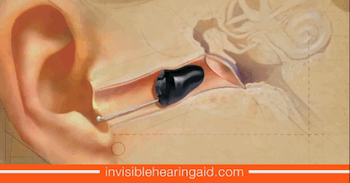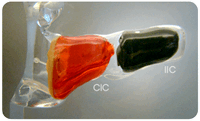
The Starkey Group is jumping into the invisible hearing aid market, with five of its brand names selling a tiny new device that fits deep within the ear canal. It also set up a web site, Invisible Hearing Aid.com, to promote what appears to be a common platform product that is being shared by all five Starkey Group companies — Starkey Laboratories, NuEar, MicroTech, AudioSync, and Audibel. Each brand is selling the digital device under its own name, but all the hearing aids feature similar technology and features, including: a design enabling deep insertion within the “second bend” of the ear canal, making it nearly impossible to see; a 16-channel digital signal processor; processing software with noise reduction and “speech preservation;” feedback cancellation; and an innovative “T2” controller enabling you to adjust volume and memory settings from your cell phone or touch-tone phone.

Using a common technology platform for products sold under multiple brands is a tried-and-true marketing strategy (think of the Buick, Chevy, Cadillac, and Pontiac automobiles that all share the same chassis and many of the same components). But we haven’t seen as much of it in the hearing aid business. I’m not sure if Starkey Group’s plan is to provide different brands for different market segments — providing everything from entry-level to premium products — or if it’s merely been slow or reluctant to migrate the brands of companies it has acquired into the Starkey Laboratories family.
Anyone shopping for invisible hearing aids should be aware of the common technology behind the five products but should also investigate any specific differences in price or minor features. Here are the five brands and brand names:
- Soundlens, from Starkey Laboratories.
- Invisibel, from Audibel hearing products.
- iSync, from AudioSync Hearing Technologies.
- MicroLens, from MicroTech hearing products.
- MiniScopic, from NuEar hearing products.
The Starkey Group products are the latest entry in the invisible in-the-canal (IIC) category of super-small hearing aids. One of the first and best-known IIC products is the Lyric Hearing Aid, an extended-wear device which fits more deeply in the ear canal than other entries in the category, but which requires the assistance of an audiologist for insertion and removal when batteries expire after several months of continuous wear. The Starkey Group invisible hearing aids aren’t inserted quite as deeply as the Lyric Hearing Aids, but they have the benefit of easy removal by grabbing an invisible plastic filament extending to the outer ear. At the same time, like the Lyric hearing aids, they are secured within the bony portion at the “second bend” of the ear canal, so they enjoy a better fit than in-the-canal devices that sit further out in the soft-cartilage portion of the ear canal, where there is more movement and a less secure seal resulting in more feedback.
The benefits of tiny invisible hearing aids are many: because they sit so close to the ear drum, they need less power and amplification and cause less annoying feedback. The snug fit also makes them more comfortable. And users say there is a more natural sound with less “occlusion,” the stopped up feeling and echoing that happens when sound bounces too great a distance between the hearing aid’s receiver (speaker) and the ear drum. There are also drawbacks: the invisible hearing aids aren’t as helpful for people with severe hearing loss as for mild hearing loss in high frequencies. And bells and whistles such as T-coils that make it easier to hear on the phone may have to wait a while as well, until the next generation of miniature digital components comes along.
In the meantime, however, it’s gratifying to see the big manufacturers like Starkey jumping into the market with both feet.

M says
Would like to know the cost, and how easy is it to put in, and most important, to remove, seems to go in very deep
Miah says
Hi there can you guys tell me how much one will cost? Thanks
Robin Freeman says
I could not agree more with Claudia’s comments! Using the advertising line:
“No one wants to be seen wearing hearing aids”
is so utterly OFFENSIVE that I cannot even begin to imagine how a corporation that serves hard of hearing individuals would allow that to air. Get those demeaning and shaming ads off the air before my hard of hearing six year old and all his peers have to be sujected to them again.
Claudia Wilson says
You should be ashamed of yourselves. Your commercial is offensive to the deaf children that have no option but to use hearing aids to function in a hearing world. Why not go to the Center for Hearing and Communication in Manhattan and see small babies that have to wear hearing aids bigger than they are just to hear sound. Small hearing aids like you describe are not powerful enough for someone who is profoundly deaf. A teenager came up to me the other day crying after seeing your commercial and reading the captiion. Please take this off as soon as possible. You are doing more harm than good for the children and teen agers who have no choice but to wear powerful aids. You are saying “it is uncool to wear hearing aids. Who would want to be seen with them. It is an embarassment.” Well some children and teens have to. You are adding to bullying by this commercial. Children are starting to be bullyed or picked on because “who wants to be seen wearing hearing aids” Being in the business you need to be more sensitive to these issues involved impressional children and teens. There are ways you can advertise without continually repeating no one wants to be seen wearing hearing aids. Corporate greed at the expense of others. Please contact me and get this commercial off the air. I do not want to have to start a petition with signatures of parents and children that rely on the larger more powerful hearing aids. Thank you
Paul Rudder says
Does anyone know what the cost of the Isyncs (or other similar Starkey product) is. I am interested in them but would like to know how expensive they are before going further.
Don Smith says
My question
How do you remove the aid when it is in the ear that far ?
Steve says
Hi David,
I’m wearing a pair of these at the moment. Mine were branded as iSyncs.
My hearing loss ranges from around 60dB to 80dB and I am hearing really well with the IICs, so their fitting range does stretch to moderate/severe. Amazingly, given their small size, there’s still room for a vent, so occlusion isn’t a problem – I did try out one without a vent and some occlusion was occurring, especially when I went running.
I’ve never worn a Lyric but I have to say that if one of those goes deeper than my iSync then they are going scarily deep. I was shocked at how far I had to push the iSync in, really took some getting used to.
I haven’t tried out the T2 from my phone yet but there’s also an iPhone/iPod app for changing volume and settings – which is pretty cool and something that I hope manufacturers will continue to provide and improve. Gives hearing aids the cool factor and would be nice if we could add/remove programmes and other stuff using the iPhone.
Cheers,
Steve